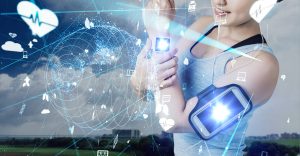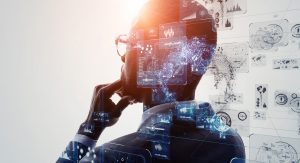How Does Digitalization Enable Personalized Healthcare?
Digitalization of Life Sciences industries is almost entirely unique. This is, in part, due to the sheer quantity of individually disruptive technologies being applied simultaneously. This extends to innovations such as Artificial Intelligence (AI) medical devices, e-health record traceability through blockchain, and simulation of the human body using digital twin technology to research preventative medicines and new procedures.
But this is not the only reason that digitalization of the Life Sciences industries is different.
Firstly, there has been a widely perceived patients’ unwillingness to adopt digital healthcare solutions. However, that this is likely correlated to the lack of trust in the quality and relevance digital healthcare solutions currently provide.
And secondly, there is concern around the potential day-to-day disruption that taking on an organisation-wide change to processes may cause. Which is precisely why it’s so important that Life Sciences organizations choose an experienced digitalization partner.
The digitalization of Life Sciences industries enables the delivery of Personalized Healthcare by tapping into the inherent value of latent patient data. By reducing the opportunity for human error. And by adopting new methods and technologies which bring patients and care providers closer together.
In doing so, we’re enabling organizations to provide accurate, detailed and individualized care from diagnosis through to treatment and cure. So, let’s take a closer look at some of the exponential technologies that are disrupting the Life Sciences industries and making Personalized Healthcare a reality.
But first, What is Personalized Healthcare?
Personalized Healthcare is a detailed and accurate provision for individual patient care. Delivered and enabled by various emergent technologies, Personalized Healthcare represents a bold new vision for Life Sciences and Healthcare industries. But there are three key terms which are used, and often misinterpreted or merged, when people talk about Personalized Healthcare:
- Personalized healthcare refers to the delivery of medical services – from diagnoses through to recovery.
- Personalized medicine refers more specifically to doctor-patient interactions.
- Precision medicine refers to the tools, strategy, and collaborative science involved in the enhancement of personalized medical care.
Big Data
Big data has phenomenal potential when properly applied in Life Sciences industries. Particularly considering the sheer volume that Health data accounts for. In fact, many universities and research institutions apply big data in their work. And while these data don’t necessarily provide consistently accurate predictions, they have exceptional statistical potential. Better yet, individual patient data can support incredible accuracy for preventative care and planning.
Using big data for predictive analysis of patient records and frequent emergency room visitors, pharmaceuticals companies can begin to gather a deeper understanding of the market. You can budget for production and iteration based on highly accurate demand predictions. And marketers can build a healthier understanding of your ideal consumer based on key demographic data.
One critical development which will support the application of big data to the Life Sciences is wearable medtech.

Devices such as smart watches can monitor our heart rate, how active we are, and even calculate our body mass index (BMI). Sweat sensors can be used to track sugar levels in diabetic patients. Oximeters monitor oxygen carried in the blood and support patients with respiratory illnesses.
Moreover, these devices empower patients to take ownership and control over their own healthcare. Given that the average patient spends less than ten minutes per year with a physician or doctor, this data could significantly improve and personalize patient care.
Artificial Intelligence
Artificial Intelligence (AI), Machine Learning, Deep Learning and Data Science are all invaluable assets to any industry. But many people are uncertain of the crucial differences between them. So, before we go through the benefits, let’s clearly define some terminology.
- Artificial Intelligence can make decisions in a similar capacity to those made by humans – specifically designed to inform and improve the quality of business decisions.
- Machine Learning is typically a suite of software algorithms able to learn from data, produce and automate further algorithms to make controlled decisions based on IFTTT (if this, then that) logic.
- Deep Learning is able to learn without human supervision. Inspired by neural networks, Deep Learning detects objects, recognizes speech, translates languages or makes decisions by drawing from unstructured and unlabelled data.
- Data Science uses scientific methods, processes systems and algorithms to extract knowledge and valuable insights from structured and unstructured data.
So, the application of Data Science can lead to the identification of new disease mechanisms, eliminate research or  discover disease similarities. Machine Learning can be used to reduce the time it takes to develop, manufacture and launch new patient therapies. Deep Learning can advance, even automate diagnostics through pattern recognition and automated immunohistochemical measurement systems. And Artificial Intelligence should be used in harmony with Human Intelligence to make informed decisions based on qualitative data predictions.
discover disease similarities. Machine Learning can be used to reduce the time it takes to develop, manufacture and launch new patient therapies. Deep Learning can advance, even automate diagnostics through pattern recognition and automated immunohistochemical measurement systems. And Artificial Intelligence should be used in harmony with Human Intelligence to make informed decisions based on qualitative data predictions.
The Healthcare sector’s spend on AI technologies is predicted to exceed $34 billion in the US alone by 2025. With applications ranging from computational drug discovery and analysis to automated report generation and patient data processing, AI is set to revolutionize almost every area of the Life Sciences and Healthcare industries.
Digital Twins
World-leading Life Sciences researchers, developers and manufacturers have contributed toward an ongoing project to simulate the human heart. The aim of this joint venture is to enable physicians and surgeons to analyze their patients’ health, plan and perform therapies and surgeries before ever making an incision.
But imagine a fully anatomically accurate, functioning model of the human body. One that could function as any patient’s medical record. Applying the value gleaned from big data and artificial intelligence, this digital twin would utterly transform the way that healthcare is provided.
At the moment, digital twins are much more pervasive in medical devices organizations, where models are much less complex than the full extent of human anatomy. However, the technology used to produce the Living Heart is capable of modelling structures from a molecular up to a population level.
In a recent interview for PharmaVoice, Steve Levine, Ph.D., Senior Director of Virtual Human Modeling Systems at Dassault Systèmes commented that,“Currently, few organizations are ready to fully capitalize on this technology, but companies are beginning to plan for this.”
In fact, the FDA is current evaluating the Living Heart as a possible replacement for patients in clinical trials. Nowadays, digital twins are proving capable of providing the level of detailed analysis necessary for BioPharma and Medical Device organizations to pass regulatory requirements. Incredibly, this approach to regulatory compliance can simultaneously save cost, reduce waste and provide detailed, predictive analytics on practically any required scale.
In Our Experience…
Many BioPharma and Medical Device companies are embracing digitalization because of the undeniable advantages that emergent technologies are presenting today. But the level of digital maturity within most of these organizations has been slow to advance.
Much of this hesitancy to commit to digitalization is due to stringent regulatory compliance, privacy and data security concerns. And while these concerns are genuine, they’re largely outdated due to phenomenal progress we’ve seen lately within our industry. But, realizing the full potential of digital transformation requires an organization to commit to a strategic, holistic approach. From End Users to C-suite, each stakeholder must understand the benefits of Product Lifecycle Management on an individual and organizational level.
The future of sustainable, personalized healthcare largely depends on organizational, even national and international commitment to digitalization. Healthcare consumers have shown that they’re ready for that change. So, how ready is your organization to embrace digital transformation?
#
Note: This post by Technia CEO Magnus Falkman first appeared on Technia’s blog